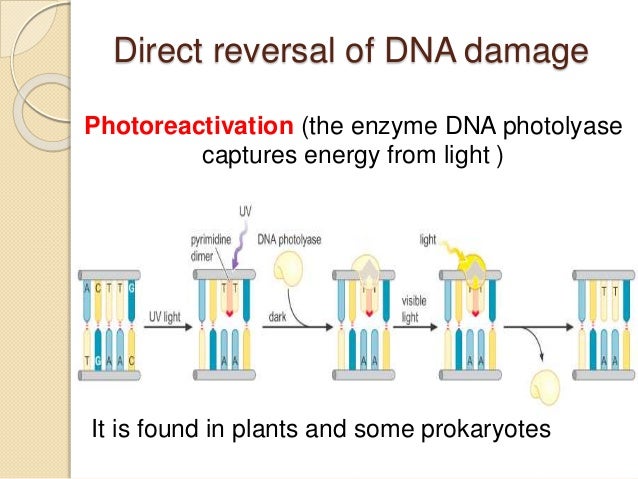
Can you repair damaged DNA? Direct reversal repair is specific to the damage. For direct reversal of alkylation events, a DNA methyltransferase or DNA glycosylase detects and removes the….
In human cells, both normal metabolic activities and environmental factors such as radiation can cause DNA damage, resulting in as many as million individual molecular lesions per cell per day. There are three types of repair mechanisms: direct reversal of the damage , excision repair , and postreplication repair. Mutational events are an inevitable part of cellular life, including internal metabolic damage and external sources of DNA damage (i.e., UV radiation, mutagens). This type of photoreactivation does not occur in humans.
DNA repair is a robust cancer defense mechanism. The damage caused by alkylating agents reacting with DNA can also be repaired through direct reversal. Methylation of guanine bases produces a change in the structure of DNA by forming a product that is complimentary to thymine rather than cytosine.
The protein methyl guanine methyl transferase (MGMT) can restore the original guanine by transferring the methylation product to its active site. See full list on news-medical. Excision is the general mechanism by which repairs are made when one of the double helix strands is damaged. The non-defective strand is used as a template with the damaged DNA on the other strand removed and replaced by the synthesis of new nucleotides.
Base-excision repair. Nucleotide excision repair. The mechanism requires a family of enzymes called glycosylases.

The enzymes remove the damaged base forming an AP site which is repaired by AP endonuclease before the nucleotide gap in the DNA strand is filled by DNA polymerase. The process involves the recognition of damage which is then cleaved on both sides by endonucl. The repair of damage to both DNA strands is particularly important in maintaining genomic integrity.
There are two main mechanisms for repairing double strand breaks: homologous recombination and classical nonhomologous end joining. Homologous recombination involves the exchange of nucleotide sequences to repair damaged bases on both strands of DNA through the utilization of a sister chromatid. Classical nonhomologous end joining connects the break ends without a homologous template through the use of short DNA sequences called microhomologies.

Studies have also found that double strand breaks can be repaired through alternative mechanisms such as single-stranded annealing and alternative joining during certain conditions. These mechanisms are mutagenic and can lead to a loss in genetic information. Single-stranded annealing provides. In nucleotide excision repair, an endonuclease makes nicks on either side of the lesion, which is then removed to leave a gap.
This gap is filled by a DNA polymerase, and DNA ligase makes the final phosphodiester bond (Fig. 16A). In base excision repair, the lesion is removed by a specific DNA glycosylase. During DNA synthesis, most DNA polymerases check their work , fixing the majority of mispaired bases in a process called proofreading. Immediately after DNA synthesis, any remaining mispaired bases can be detected and replaced in a process called mismatch repair.
Canonical nonhomologous end joining (C-NHEJ) and HDR are two major pathways engaged to repair DNA double-strand breaks (DSB). The initiation of C-NHEJ is triggered by heterodimer Ku (Kuand Ku80) that binds to the ends of DSB and recruits the DNA-dependent protein kinase catalytic subunit (DNA-PKcs) to form the DNA-PK holoenzyme. Cleavage of desired strand by CasRNA guided nuclease. Double-Strand Break Repair 5. Direct Repair : It involves the reversal of DNA damage.
Using Homology-Directed Repair for Targeted Integration. HDR is a DSBR that uses a double-stranded DNA donor that has homology to the adjacent sequences surrounding the lesion to incorporate new DNA fragments. HDR offers more precision than NHEJ and allows for seamless integration of DNA.

The earliest studied HDR pathway is HR. This requires proteins that recognize and bind to the exposed ends and bring them together for ligating. As such, the process of direct repair is completely error-free, granting a major advantage in preservation of genetic information. The structure of DNA makes it a very stable molecule.
The hydrogen bonds between complementary strands protect the most reactive parts of the molecule. Among these diverse repair pathways, direct DNA - repair systems provide cells with simple yet efficient solutions to reverse covalent DNA adducts. O It uses an exonuclease to remove the incorrect sequence and replace it.
O It removes functional groups or bonds from the altered nucleotide to restore the original structure. O It uses the other copy of the DNA molecule to replicate the original sequence. View the animation below, then complete the quiz to test your knowledge of the concept.
UV light and other ionizing radiations damage DNA molecules.
No comments:
Post a Comment
Note: Only a member of this blog may post a comment.